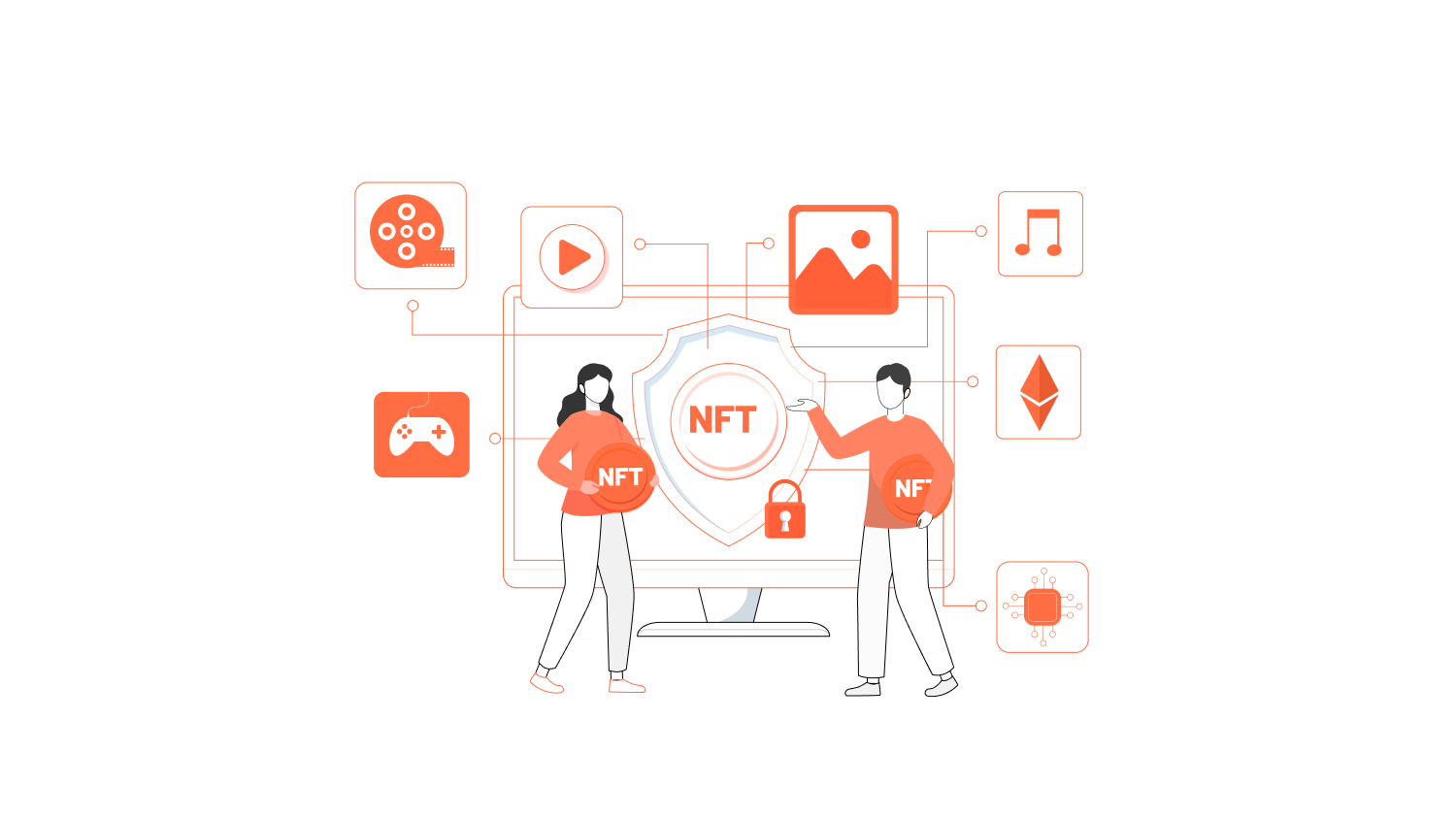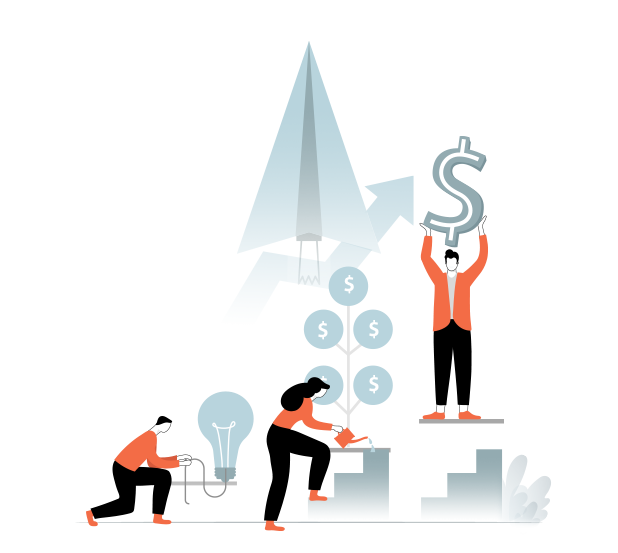Want to learn how to create an NFT? You’ve landed at the right place! The overnight story of American digital artist Mike Winkelmann aka Beeble, who sold his NFT piece – Everydays: The First 5000 Days – for a whopping $69 million at an auction, shows what NFTs (non-fungible tokens) can do to our lives.
But NFTs are much more than the rags to riches stories and digital artwork you see online.
In this blog, we’ll discuss everything you need to know about NFT – from the basics to the advanced, from creating an NFT to selling it – and help you get a clear understanding of this booming industry on the internet.
Let’s start by answering the most important question:
What is an NFT?
In simple terms, an NFT is a digital asset that represents the objects in the real world, such as cars, music, art, collectables, in-game items, videos etc., that can be traded online.
It is secured by a blockchain, usually Ethereum. That means you can buy and sell NFTs. Each token’s value can increase or decrease depending on the growth of the NFT market
The term non-fungible comes from economics. It is used to define things that cannot be interchanged because of their unique properties. A simple example of a non-fungible item is the furniture at your home.
The most defining features of an NFT are:
-
-
- It cannot be copied
- Another token cannot replace it
- It comes with a unique code that differentiates it from other digital replicas
- It gives you the ultimate ownership right of a digital asset
- It can help people verify the ownership of a digital asset
-
Understanding NFT
The purpose of NFT is simple – to make digital assets unique and ensure their authenticity through ownership.
Here’s an example:
Let’s consider banknotes. If you have a $100 bill, you can swap it for two $50 bills or other equal denominations. Or even exchange your $100 bill for your friend’s $100 bill. So, your currency is a fungible asset since it’s interchangeable.
Non-fungible assets are the exact opposite of fungible assets. They cannot be exchanged. For example, when you create an NFT, it will be unique. Unlike cryptocurrencies, It cannot be replaced by another token.
So are NFTs like cryptocurrencies?
Not exactly. According to experts, NFTS are transferable assets secured by Ethereum or any other blockchain. Cryptocurrencies are also protected by blockchain, but they are fungible assets. That is, you can exchange them.
If you’re wondering what a blockchain is, here is a simple definition:
A blockchain is a system that helps you record digital information with ultimate security. You cannot hack, change or cheat a blockchain system.
It stores all transactional details of digital assets such as NFTS, cryptocurrencies, etc., within a network connected to thousands of computers across the world.
How does an NFT Work?
NFT relies on blockchain technology to verify the ownership and authenticity of each asset. Your right to ownership of an NFT is fixed in a blockchain, so nobody can snatch it from you.
You can manage the ownership of your NFT with the help of a unique ID exclusive to your asset. Whenever you create an NFT, your details will be added to the blockchain.
The creation of an NFT can be majorly defined in three steps:
-
-
- Creating a new block
- Validating information
- Recording information into the blockchain
-
Some examples of NFTs are:
-
-
- Digital art
- In-game avatars
- Event tickets
- Collectables
- Domain names
- Signatures
- Legal documents
-
Each NFT comes with a set of unique properties such as:
-
-
- Presence of a unique identifier linked to the blockchain address.
- A verifiable ownership
- NFTs can only be traded via a blockchain-based NFT market
-
Why are NFTs Relevant?
An NFT lets you tokenise digital assets ranging from artwork to real estate. Presently, almost every digital asset stands a chance to be copied or replicated. So, the industries where NFTs come into play are expanding.
However, cashing in on NFTs helps businesses create unique digital assets with authentic ownership. That is, no two NFTs will be the same. This opens up tremendous opportunities for businesses of every size and shape.
For example, music streaming services like Spotify could package the personal playlists of famous artists and sell them to their fans.
NFTs can also impact the booming creator economy by enabling content creators to sell their NFTs and access a global market. Moreover, you will soon see banks accepting NFTs as collateral for disbursing loans!
Today, the ultimate ownership of a digital asset is a concern. With an NFT, you can easily prove your ownership over an asset, removing the copy/paste problem completely.
In a nutshell, NFT can be used to:
-
-
- Boost earnings for content creators
- Own digital assets
- Enhance gaming experience with in-game assets
- Improve your brand awareness among target groups
-
How to Create & Sell an NFT?
Creating an NFT to sell is not a piece of cake. It is not about “just selling your cat’s photo as NFT”. Let’s better understand NFTs before jumping into the bandwagon of creators.
Technically, you can trade every digital file as NFT. But if you’re planning to sell your NFT through a marketplace like OpenSea, there will be limitations to the file formats they support.
Most NFTs are traded on Ethereum. So when you create an NFT and intend to sell it, you need to pay a transaction fee called gas. The gas fee can vary depending on your requirements.
That is, everything you do on the blockchain – from minting NFTs to trading them – will cost you a gas fee. But paying gas fees doesn’t guarantee your transfer will go through. In most cases, it will.
But here’s the catch:
You won’t get the gas fee back even if your transfer fails.
Here’s a step-by-step process to list your NFT on a marketplace
1. Choose an NFT marketplace
You need a valid marketplace to sell your NFT. There are a handful of marketplaces that use different blockchains.
Here is a list of best NFT marketplaces and the blockchain they use.
-
-
- OpenSea [Ethereum]
- AtomicHub [Wax blockchain]
- Rarible [Flow blockchain]
-
OpenSea and Rarible have what they call “lazy minting” systems. That is, you can create NFTs on these marketplaces without paying a penny!
What does lazy minting do?
It lets you create an NFT and upload it on the marketplace for sale without writing it on the blockchain, thus saving gas fees.
So, how do these platforms charge you?
Here’s the deal:
The gas fee is bundled with the transfer charges you must pay when someone buys your NFT. So you only pay when you close a deal! Then your NFT will be written on the blockchain.
However, be wary of the initiation charges of OpenSea for first-time users. When you list your first NFT on OpenSea, they will charge you for initialising your account. This one-time fee can cost you between $200-$400.
2. Set up your crypto wallet
You need wallets to store your crypto assets and NFTs that you create or buy. A crypto wallet stores your private keys, keeping your crypto assets safe and accessible. These wallets can be in both physical and digital forms.
For example – Coinbase is a digital wallet, and Ledger is a physical wallet that looks like a USB stick.
You might be wondering:
How does a crypto wallet work?
A crypto wallet doesn’t really store your crypto assets written on the blockchain. Instead, it keeps private keys [passwords] that help you access your crypto assets like bitcoins, NFTs etc. These private keys stored in your wallet confirm your ownership of a crypto asset.
Remember:
Your wallet should be compatible with the blockchain you’re using.
For example, you can’t use an Ethereum-based wallet to purchase an NFT written in the Wax blockchain.
Some of the most popular crypto wallets are:
-
-
- MetaMask: It is a wallet supported by Ethereum-based marketplaces like OpenSea, which can be used as a Chrome / Firefox extension or iOS/Android app.
- Coinbase Wallet: A crypto wallet compatible with blockchains like Ethereum, Polygon, and others. It is an ideal pick if your crypto assets are spread across multiple blockchains.
-
You can set up your crypto wallet as quickly as signing up for a usual product or service.
But remember the 12 random words called “seed phrase” that MetaMask and Coinbase generate for your profile.
You’ll need to use this seed phrase while setting up your account on a new device.
So, it will be a good idea to save them safely in a convenient place.
3. Connect your crypto wallet to a marketplace
After setting up your crypto wallet, you need to connect it to the marketplace you wish to create and sell your NFT.
For example, if you’re selling your NFT on OpenSea, visit their website and click “create”.
You will be redirected to a new tab that contains a list of popular crypto wallets compatible with OpenSea.
You can choose the crypto wallet you wish to connect with your OpenSea account. That’s it, and your wallet will be connected to the marketplace.
4. Create your NFT
Let’s get to the core part – How to create your NFT. A work that could change your life overnight, just like Beeble (Though the odds are shallow!)
Here’s how you can create an NFT on OpenSea:
-
-
- Visit OpenSea website
- Go to: My Collections on the top right of your profile> Click on Create a Collection.
- Fill out all the details and upload the file you’ll sell as your NFT. You can choose the file format, give a name to your file, include external links to your social media, and add a description.
- Pick the blockchain you want to mint your NFT to. You can choose either Ethereum or other blockchains like Polygon one.
- Cross-check the information of your NFT as you can’t edit it once it’s written on the blockchain.
- Click the “Create” button.
-
And voila! Your NFT will be created.
5. Decide your pricing strategy
The next part is deciding how to price your NFT to sell it.
There are three pricing strategies:
-
-
- Fixed pricing: You give a fixed price for your NFT and put it up for sale.
- Timed Auction: You can put up your NFT for auction with a base cost for a fixed time. You can decide the duration of your auction.
- Bidding: Your NFT will be open for bid, and people can bid on your NFT to purchase it. You can either accept or reject their offers based on your choice.
-
After deciding the price strategy, choose the currency you would like to receive for your NFT.
Next, you can set the unlockable content for the buyer. It could be anything from a Thank You message to an invite to your private Discord channel to further discuss the deal.
6. Mint your NFT
To initiate your Ethereum wallet, you need to do a one-time transaction. OpenSea charges you a gas fee associated with initialising your account. So if you’re a first-time user, you will need to pay for minting your NFT.
7. List your NFT
After you’ve finished working on your pricing strategy, go ahead and list your NFT for sale on OpenSea by clicking the Complete Listing button.
You can list your NFT after signing a few transactions with your crypto wallet. Now you’ll see a screen announcing that your NFT has been listed for sale.
How Much Does it Cost to List Your NFT on OpenSea?
According to experts, it costs you anywhere from $200- $450 to list an NFT on OpenSea if you’re a first-time user. The cost is dependent on the gas fee you pay when you’re listing an NFT. It varies from time to time. You can check out popular gas fee trackers to understand the live gas fee on different marketplaces.
Takeaway
So, are NFTs worth all the hype or just another fad?
With many creators and businesses joining the bandwagon and cashing in on digital assets, NFT is definitely here to stay. Plus, the sales of NFTs are skyrocketing – from around $41 million in 2018 to a jaw-dropping $44+ billion in 2021.
As an entrepreneur, perhaps it would be best for you to invest in NFTs now or in the near future – either as a creator or as a service provider in the industry.




